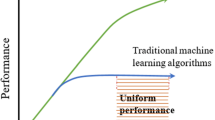Abstract
Sepsis poses a serious threat to health of children in pediatric intensive care unit. The mortality from pediatric sepsis can be effectively reduced through in-time diagnosis and therapeutic intervention. The bacilliculture detection method is too time-consuming to receive timely treatment. In this research, we propose a new framework: a deep encoding network with cross features (CF-DEN) that enables accurate early detection of sepsis. Cross features are automatically constructed via the gradient boosting decision tree and distilled into the deep encoding network (DEN) we designed. The DEN is aimed at learning sufficiently effective representation from clinical test data. Each layer of the DEN filtrates the features involved in computation at current layer via attention mechanism and outputs the current prediction which is additive layer by layer to obtain the embedding feature at last layer. The framework takes the advantage of tree-based method and neural network method to extract effective representation from small clinical dataset and obtain accurate prediction in order to prompt patient to get timely treatment. We evaluate the performance of the framework on the dataset collected from Shanghai Children’s Medical Center. Compared with common machine learning methods, our method achieves the increase on F1-score by 16.06% on the test set.
Similar content being viewed by others
References
FLEISCHMANN C, SCHERAG A, ADHIKARI N K J, et al. Assessment of global incidence and mortality of hospital-treated sepsis. Current estimates and limitations [J]. American Journal of Respiratory and Critical Care Medicine, 2016, 193(3): 259–272.
SINGER M, DEUTSCHMAN C S, SEYMOUR C W, et al. The third international consensus definitions for sepsis and septic shock (sepsis-3) [J]. JAMA, 2016, 315(8): 801–810.
DESAUTELS T, CALVERT J, HOFFMAN J, et al. Prediction of sepsis in the intensive care unit with minimal electronic health record data: A machine learning approach [J]. JMIR Medical Informatics, 2016, 4(3): e28.
DESAUTELS T, HOFFMAN J, BARTON C, et al. Pediatric severe sepsis prediction using machine learning [EB/OL]. (2017-11-22). https://www.biorxiv.org/content/10.1101/223289v1.
ZHANG Z H, HONG Y C. Development of a novel score for the prediction of hospital mortality in patients with severe sepsis: The use of electronic healthcare records with LASSO regression [J]. Oncotarget, 2017, 8(30): 49637–49645.
LE S, HOFFMAN J, BARTON C, et al. Pediatric severe sepsis prediction using machine learning [J]. Frontiers in Pediatrics, 2019, 7: 413.
CALVERT J S, PRICE D A, CHETTIPALLY U K, et al. A computational approach to early sepsis detection [J]. Computers in Biology and Medicine, 2016, 74: 69–73.
FUTOMA J, HARIHARAN S, HELLER K. Learning to detect sepsis with a multitask Gaussian process RNN classifier [C]//34th International Conference on Machine Learning. Sydney: ICML, 2017: 1174–1182.
FUTOMA J, HARIHARAN S, HELLER K. An improved multi-output Gaussian process rnn with realtime validation for early sepsis detection [C]//2nd Machine Learning for Healthcare Conference. Boston: PMLR, 2017: 243–254.
FRIEDMAN J H. Greedy function approximation: A gradient boosting machine [J]. The Annals of Statistics, 2001, 29(5): 1189–1232.
HE X R, PAN J F, JIN O, et al. Practical lessons from predicting clicks on ads at Facebook [C]//Eighth International Workshop on Data Mining for Online Advertising. New York: ACM, 2014: 1–9.
ARIK S O, PFISTER T. TabNet: Attentive interpretable tabular learning [EB/OL]. (2020-12-09). https://arxiv.org/abs/1908.07442.
IOFFE S, SZEGEDY C. Batch normalization: Accelerating deep network training by reducing internal covariate shift [C]//International Conference on Machine Learning. Lille: PMLR, 2015: 448–456.
DAUPHIN Y N, FAN A, AULI M, et al. Language modeling with gated convolutional networks [C]//International Conference on Machine Learning. Sydney: PMLR, 2017: 933–941.
MARTINS A, ASTUDILLO R. From softmax to sparsemax: A sparse model of attention and multilabel classification [C]//International Conference on Machine Learning. New York: PMLR, 2016: 1614–1623.
FLEMING S, THOMPSON M, STEVENS R, et al. Normal ranges of heart rate and respiratory rate in children from birth to 18 years of age: A systematic review of observational studies [J]. The Lancet, 2011, 377(9770): 1011–1018.
CHAWLA N V, BOWYER K W, HALL L O, et al. SMOTE: Synthetic minority over-sampling technique [J]. Journal of Artificial Intelligence Research, 2002, 16: 321–357.
HOCHREITER S, SCHMIDHUBER J. Long short-term memory [J]. Neural Computation, 1997, 9(8): 1735–1780.
RUMELHART D E, HINTON G E, WILLIAMS R J. Learning internal representations by error propagation [M]//Parallel distributed processing: Explorations in the microstructure of cognition: Foundations. Cambridge: MIT Press, 1987: 318–362.
CRAMER J S. The origins of logistic regression [EB/OL]. (2003-01-25). https://ssrn.com/abstract=360300.
CORTES C, VAPNIK V. Support-vector networks [J]. Machine Learning, 1995, 20(3): 273–297.
ALTMAN N S. An introduction to kernel and nearest-neighbor nonparametric regression [J]. The American Statistician, 1992, 46(3): 175–185.
HO T K. Random decision forests [C]//3rd International Conference on Document Analysis and Recognition. Montreal: IEEE, 1995: 278–282.
HE K M, ZHANG X Y, REN S Q, et al. Deep residual learning for image recognition [C]//2016 IEEE Conference on Computer Vision and Pattern Recognition. Las Vegas: IEEE, 2016: 770–778.
VAN DER MAATEN L. Accelerating t-SNE using tree-based algorithms [J]. Journal of Machine Learning Research, 2014, 15(1): 3221–3245.
BORG I, GROENEN P. Modern multidimensional scaling: Theory and applications [J]. Journal of Educational Measurement, 2003, 40(3): 277–280.
TIPPING M E, BISHOP C M. Probabilistic principal component analysis [J]. Journal of the Royal Statistical Society: Series B (Statistical Methodology), 1999, 61(3): 611–622.
Author information
Authors and Affiliations
Corresponding author
Rights and permissions
About this article
Cite this article
Chen, X., Zhang, R., Tang, X. et al. Prediction of Pediatric Sepsis Using a Deep Encoding Network with Cross Features. J. Shanghai Jiaotong Univ. (Sci.) 29, 131–140 (2024). https://doi.org/10.1007/s12204-022-2499-1
Received:
Accepted:
Published:
Issue Date:
DOI: https://doi.org/10.1007/s12204-022-2499-1
Key words
- pediatric sepsis
- gradient boosting decision tree
- cross feature
- neural network
- deep encoding network with cross features (CF-DEN)




